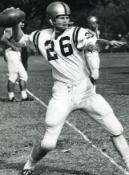
Steve Tensi
A History of Passing Quarterbacks
By Jim Joanos
At Florida State University the football team is in the midst of spring practice. One of the questions being asked most is "Who will be FSU's starting quarterback when next football season begins?" Fans are guessing whether it will be Drew Weatherford or Xavier Lee or one of the two red shirt freshmen, D'Vontrey Richardson or Christian Ponder. It is an important question. FSU has a new offensive coordinator in Jimbo Fisher who is in the process of installing changes into the FSU offensive scheme. The quarterback will be the main ingredient in that new system.
The importance of the quarterback in FSU's system is nothing new. Ever since head coach Bill Peterson in 1964, installed a professional-style offense with a major emphasis on passing, the position of quarterback has occupied center stage at FSU. The play of the quarterback has more than any other position been the big factor in FSU's success through the years. FSU has had some fine passing quarterbacks and it is a pleasure to remember some of them.
 |
Steve Tensi |
Steve Tensi was the quarterback when Coach Pete led the college football world into a major emphasis on passing in 1964. Before that memorable season, Joe Majors had held the FSU school passing records for a season, set in 1959, of pass attempts (168), completions (90), yards ( 1063), and touchdowns (7). In 1964, Tensi shattered all of those records recording 204 attempts, 121 completions, 1681 yards, and 14 touchdowns in that season. Those of us who witnessed the 1964 season well remember the long, high arching passes that Tensi threw to FSU's first consensus All American, wide receiver Fred Biletnikoff.
Especially sweet was the 55 yard touchdown pass from Tensi to Biletnikoff in the first ever victory over the University of Florida that was achieved that year. The five touchdown passes that Tensi threw, four to Biletnikoff, in the Gator Bowl game at the end of the season when FSU walloped Oklahoma still ranks as one of the greatest performances by an FSU quarterback.
There were other great passing quarterbacks during the Peterson era. Kim Hammond in 1967 led FSU to a 7-2-2 record including a trip to the Gator Bowl. In the process, he threw for 1991 yards and 15 touchdowns that season. Both of those accomplishments were team records at the time. Hammond was also the quarterback that led FSU to the historic 37-37 tie against Alabama and Bear Bryant in Birmingham, and the first victory at Gainesville over the Gators, 21-16, that same year. Hammond was knocked unconscious early in that game against Florida, but returned late in the game in historic fashion. In three plays, two of which were passes to All American wide receiver Ron Sellers, Hammond moved the team almost the full length of the field to score and reestablish control of the game.
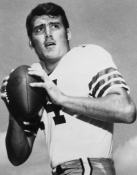 |
Bill Cappleman |
Bill Cappleman, the "passing machine" led the offense during the 1968 and 1969 seasons. In the three seasons that he played varsity ball he amassed 4904 yards through the air. That was outrageous at the time.
Gary Huff, "the Magic Dragon", was the quarterback leader in head coach Larry Jones' first two years at FSU, 1971 and 1972. His performance in the first ever Fiesta Bowl game at the end of the 1971 season against Arizona State is definitely on the list of all time great performances by an FSU quarterback. Although FSU lost the game, 45-38, Huff threw for 347 yards that day to seven different players, and was named the most outstanding offensive player of the game. He went on to an outstanding career in the NFL.
Bobby Bowden has been the head coach since the 1976 season.
During his tenure, the list of legendary quarterbacks at FSU has grown considerably. Some of my favorite recollections are about the two-headed quarterback system that FSU used during three seasons from 1977 through 79 when Wally Woodham and Jimmy Jordan shared the spotlight. Both were great passers and seemed to alternate games in which each would have fantastic performances. They led FSU to its first ever appearance in the Orange Bowl game following the 1979 season. Rick Stockstill who followed them also helped get FSU into a second consecutive Orange Bowl game after the 1980 season. He threw fifteen touchdown passes in all during the 1980 season.
One of my all time favorites was Danny McManus who led the team in 1986 and 87. While he was not as fancy as some of the others, he knew how to win. He led his team to bowl victories in both of those seasons, 27-13 over Indiana in the All American Bowl (1986) and 31-28 over Nebraska in the Fiesta Bowl (following the 1987 season). In the Fiesta Bowl he passed the team down the field beginning at FSU's own three yard line. The final pass for the winning touchdown was thrown from the 15-yard line to Ron Lewis who had run a squared in route into the end zone. His performance in 1987 led the team to an 11-1 record and a second place final ranking by the Associated Press Poll and the United Press International polls, the highest that FSU had attained up to that point.
Chip Ferguson led the Seminoles to a 11-1 record including a 13-7 win over Auburn in the Sugar Bowl during the 1988 season. As a freshman he had a spectacular game following the 1985 season when he passed the Seminoles to a 34-23 victory over Oklahoma in the Gator Bowl. In that game he had passed for two touchdowns and run for another. For that performance, in 2005, he was selected to membership in the Gator Bowl Hall of Fame.
Peter Tom Willis had limited playing time during his first three years at FSU being forced to back up Danny McManus and Chip Ferguson. However, in his senior year in 1989, he more than made up for it. He led the team to a 10-2 record including another victory (41-7) over Nebraska in the Fiesta Bowl. His performance that year was probably the most productive for a quarterback in a single season up to then as he threw for 3124 yards and 20 touchdowns. It was simply a fantastic year that was good enough for a final national ranking of third in the AP poll.
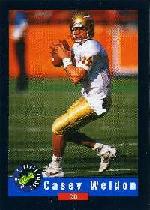 |
Casey Weldon |
Casey Weldon was runner-up for the Heisman Trophy following the 1991 season. That was the season that FSU demolished Michigan at Ann Arbor, 51-31. He threw 22 touchdown passes that year and won the Johnny Unitas Golden Arm award that is given to the nation's best passing quarterback as determined by the sponsors of that award. In both the 1990 and 91 seasons he led the Seminoles to fourth place finishes in the AP polls. He also led FSU efforts in two bowl victories over Penn State in the Blockbuster Bowl and over Texas A & M in the Cotton Bowl.
A National Championship and a Heisman
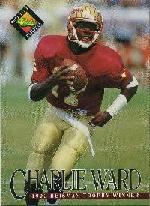 |
Charlie Ward |
Charlie Ward not only won the Heisman Trophy in 1993 as the most outstanding football player of the year but led the FSU team to its first ever National Championship that same season. He is the most decorated football player in FSU history in that he won numerous other awards in 1993 including the Dave O'Brien award for the number one quarterback in the country, the Johnny Unitas Golden Arm award, and the Maxwell Award presented by the sponsors of that award to the player determined to be the best in the country for the season. During that fabled season, Ward completed 204 of 365 passes for 27 touchdowns with but 4 interceptions. The season before, 1992, he had led the Seminoles to a 11-1 record and second place in the national rankings. Ward was designated the conference player of the year in the Atlantic Coast Conference for both the 1992 and 1993 seasons.
Danny Kanell quarterbacked the team to a pair of national fourth place finishes in 1994 and 1995. When he finished his career at FSU he had thrown 57 touchdown passes, the record at that time. His 32 td passes in 1995 was five more than Charlie Ward had thrown in 1993, the previous season record. He was the Atlantic Coast Conference player of the year for his work during the 1995 season. He also led the FSU team to two bowl victories, 23-17 over Florida in the Sugar Bowl (following 1994 season), and 31-26 over Notre Dame in the Orange Bowl (1995).
Thad Busby was the starting quarterback for the Seminoles during the 1996 and 97 seasons and led the team to national third place finishes both years. At the end of the 1996 season, the Seminoles lost the national championship game at the Sugar Bowl to the University of Florida. Earlier FSU had handed the Gators their only defeat of that season when the Seminoles beat Florida 24-21 in Tallahassee. In Busby's last game as a Seminole, the team beat Ohio State, 31-14, in the Sugar Bowl.
Another National Championship and Another Heisman
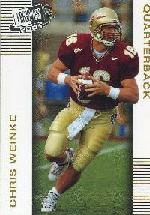 |
Chris Weinke |
Chris Weinke's "reign of terror" as the Seminoles' starting quarterback ran for three seasons, 1998, 1999, and 2000. After each of those seasons, FSU played for the national championship. In 1998 the Seminoles lost to Tennessee in the Fiesta Bowl without the services of Weinke who had been injured earlier. The 1999 season was the best ever for the Seminoles who led the country in the polls from the beginning to the end when they whipped Virginia Tech 46-29 in the Sugar Bowl for the national championship. The combination of Weinke, passing, and Peter Warrick catching was just too much for the Hokies to stop. Warrick's touchdown reception of a 43-yard pass from Weinke late in the game ranks as one of the most spectacular catches in FSU's history. Diving into the end zone with one of Tech's defensive backs hanging all over him, Warrick held on for the score. FSU's only loss during the 2000 regualar season came against Miami early on but did not prevent the Seminoles from meeting Oklahoma for the national championship at the Orange Bowl at the end. The Seminoles lost 13-2. For his efforts during the regular season, Weinke became the second Seminole to win the Heisman Trophy. At the end of the 2000 season, he was also awarded the Davey O'Brien and the Johnny Unitas awards. At the end of his career following the 2000 season, Weinke held nearly all of the FSU passing records. He still holds a number of them including: most touchdown passes in a season (33 in 2000) and a career (79); longest pass completion ever (98 yards to Marvin "Snoop" Minnis in 2000 for a touchdown against Clemson); most 300-yard passing games (14, from 1997 through 2000); most yards passing in a single game (536 vs. Duke in 2000); most passing yards in a season (4167 in 2000); most passing yards in a career (9839 from 1997-2000); career completions (650 from 1997-2000).
Chris Rix was FSU's primary quarterback from 2001 through 2003. While FSU fell off somewhat in its national success during those seasons, it nevertheless won the Atlantic Coast Conference in two of those seasons (2002 and 2003), stayed within the nation's top 25 programs all three seasons, and Rix compiled some impressive passing statistics in the process. Nine times he threw for over 300 yards in a game. He ranks second in FSU's record book for career completions (575), career yards (8390) and for career td passes (63).
Hope for the Coming Years
Drew Weatherford and Xavier Lee will be juniors when next season begins. Weatherford has started more games and had an impressive year in 2005 when the team managed to win the ACC with a victory over Virginia Tech in the first ever conference post season championship game and played in the Orange Bowl. Lee got a few starts this past year. Both have been outstanding at times but consistency has been lacking. Hopefully, the new innovations in the program will aid each to become more dependable. The current battle for the starting job will more than likely be won by one of the two rather than one of the red shirt freshmen, Christian Ponder or D'Vontrey Richardson, but you never can tell. According to new Offensive Coordinator and Quarterbacks Coach Jimbo Fisher, all four will get a good look.
Whoever gets the main job will have a major task ahead of them in reaching the levels of performance achieved by some of those folks that preceded them. The FSU fan base has grown quite accustomed to excellence at the quarterback position and looks forward to returning to that success so well enjoyed earlier. We sure hope that whoever wins the job will lead us there. Let us wish all four of them good luck in their quest.